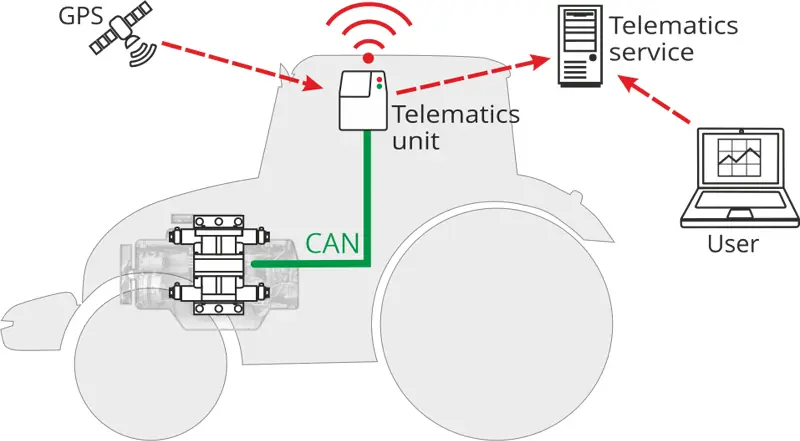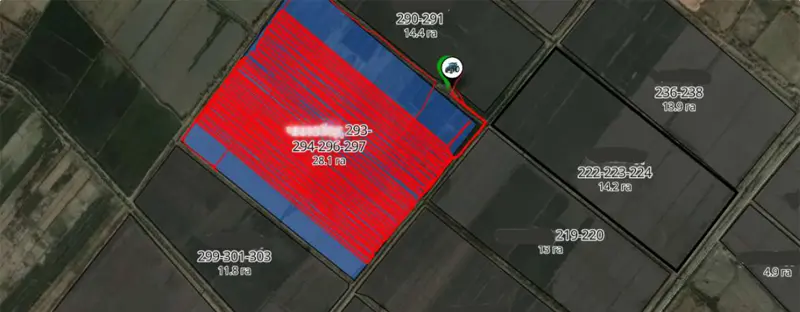Monitoring of tractor agricultural machinery for growing and harvesting cotton, Uzbekistan
Monitoring of tractor agricultural machinery for growing and harvesting cotton, Uzbekistan
![]() Customer:
Customer:
manufacturer of cotton and cotton products*
![]() Task:
Task:
- fuel consumption and machine-hours monitoring
- hours worked and quality of work of drivers tracking
- tracking departure from fields by geofences
![]() Machinery:
Machinery:
tractors
![]() Solution:
Solution:
DFM D fuel flow meters
![]() Result:
Result:
fuel consumption reduced by 35%
Customer
Company* was founded in 2020. The company is a cotton cluster, covering the entire process from growing raw materials to manufacturing finished garments. It has its own cotton fields and produces yarn, fabrics, and various types of sewn products on 10 production lines.
![]() 1300+ employees
1300+ employees
![]() 12 000 hectares of cotton fields
12 000 hectares of cotton fields
![]() 25 units of machinery
25 units of machinery
![]() 450 000 products are sewn per month
450 000 products are sewn per month
Machinery
The fleet of machinery used in the cotton fields consists of:
- Universal tractors Claas Arion, 160 hp – 3 units.
- Universal tractors Case Puma, 220 hp – 2 units.
- Universal-plow tractors MTZ-80, 80 hp – 5 units.
- Cotton-specific tractors TTZ LS100, 78 hp – 5 units.
- Universal tractors New Holland TD5, 110 hp – 5 units.
- General-purpose tractors Kirovets, 300 hp – 1 unit.

Task
Reducing costs in cotton cultivation is a top priority for the management of company*. A significant portion of these costs is comprised of fuel for the machinery and the salaries of tractor operators and combine harvester operators.
Fuel consumption quotas were established based on the manufacturer’s specifications. Consumption was calculated based on machine-hours, which included actual work and numerous transitions between fields. Actual fuel consumption was not measured.
Operators’ salaries were calculated based on the standard working hours. In order to increase their salaries, tractor operators manipulated the machine-hours counters by leaving the engine running idle.

The management of the company* decided to implement a agricultural machinery monitoring system that allows them to:
- Determine machine-hours by engine modes – load, idle.
- Measure fuel consumption – both overall and by engine modes.
- Assess the quality of work in field and record departures from fields.
Solution
Components of the machinery monitoring system:
- DFM D fuel flow meter with CAN interface,
- Bitrek telematics unit with CAN input,
- Cropio telematics service.
DFM D fuel flow meter directly measures fuel consumption in the engine’s feed and return lines. Instant fuel consumption, fuel and working time counters for different engine modes (idle, under load, overload) are transmitted via the CAN J1939 interface.
The fuel flow meter also detects attempts to manipulate fuel consumption using air or magnetic interference and sends alerts accordingly. The data is transmitted to the monitoring terminal and further to the telematics service.
The telematics service provides the customer with online data on fuel consumption and the vehicle’s position, as well as generates reports on fuel usage, engine performance, and machinery movement.

Machinery monitoring system
It determines the area covered, distance traveled, displays fuel consumption and working time during field operations and tractor transfers. The management of the company analyzes the reports and makes decisions to optimize operations and enhance agricultural process productivity.

Online tracking of field operations

Example of an analytical report

Tamataev Vitaliy, Technical Director, Technoton GPS, Uzbekistan
“For fuel and engine runtime monitoring, we proposed to the client a monitoring system based on the DFM D fuel flow meter. The flow meter provides accurate data on fuel consumption and engine runtime based on different engine modes. These data will help client to optimize agricultural processes.
The installation of a differential fuel flow meter has pleasant advantages such as simplicity (no need to change the engine’s fuel system) and speed (minimal downtime for the machinery during installation).”
Result
- After the installation of the machinery monitoring system, fuel consumption was no longer based on quotas but on actual usage. Fuel costs decreased by 35%.
- Data analysis regarding machinery transitions between fields allowed for movement routes optimization. Transit time was reduced by 70%.
- Idle running of machinery for prolonged periods ceased, as the operators’ salaries now directly depend on the actual work performed.
- Detailed analytical reports led to a 40% increase in agricultural process productivity.

Director of agricultural company*, Uzbekistan
"The DFM fuel flow meters provide reliable information on fuel consumption and engine runtime. The expectations we had for the machinery monitoring system have been fully met. The system's analytical reports provide us with the necessary information for optimizing agricultural processes. Once we accumulate data on engine operation in various engine modes, we will be able to implement a predictive maintenance system instead of scheduled maintenance."
* Data is hidden from public access to comply with GDPR requirements. Details on the project can be disclosed upon signing NDA and with the consent of our partner.

